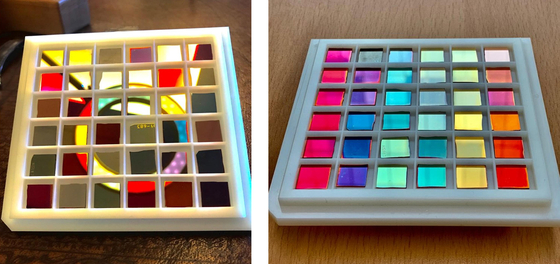![The oxidized single crystal copper thin film has a total natural color. [사진 IBS]](https://i0.wp.com/pds.joins.com/news/component/htmlphoto_mmdata/202103/11/7812f4b5-c3b4-48a1-a2a7-80f8556136f4.jpg?w=560&ssl=1)
The oxidized single crystal copper thin film has a total natural color. [사진 IBS]
The original color of copper is bright reddish brown, or’copper’. However, over time, it turns into a dark blue-green color with oxidation, that is, rust. The statue of Yi Sun-sin in Gwanghwamun and the Statue of Liberty in New York, USA are made of copper alloy. Both were bright’copper’ at first, but rusted in slightly different colors depending on the difference in the ratio of the copper alloy component. However, the power of science and technology can change the color of copper to full natural color.
IBS Younghee Lee, Director of Nanostructure Physics Research Center
By oxidizing a 0.2nm thick copper thin film layer
Implement color by adjusting the thickness
Used for cryptographic etching, semiconductor devices, etc.
Director Lee Young-hee (Professor of the Department of Energy Science, Sungkyunkwan University), Director of the Institute of Basic Science (IBS) Nanostructure Physics Research Center, worked with Prof. Seyoung Jeong of Pusan National University and Prof. Woo-Seok Choi of Sungkyunkwan University. It was announced on the 11th that it was successful.
The researchers first made an extremely flat single crystal copper thin film with a thickness of 0.2 nm (a nanometer and 1 nm is 1 billionth of a meter). The research team used a self-developed’Atom Sputtering Epitaxy’ device. The copper thin film made in this way is transparent like glass. By controlling the oxidation direction of the copper thin film, the researchers were able to control the thickness of the oxide layer, that is, rust, to produce a vivid, full-colored copper.
![The principle that the copper thin-film oxide layer reflects visible light of different wavelengths (colors) depending on the thickness and stands out. [사진 IBS]](https://i0.wp.com/pds.joins.com/news/component/htmlphoto_mmdata/202103/11/7d65d5f5-172f-4428-8674-16d7e7427538.jpg?w=560&ssl=1)
The principle that the copper thin-film oxide layer reflects visible light of different wavelengths (colors) depending on the thickness and stands out. [사진 IBS]
Director Young-hee Lee said, “Color is when a certain wavelength of visible light is reflected and comes into the eye.” “He said.
The researchers also demonstrated an’oxide-lithography’ technology that uses a laser to oxidize only a portion of the surface. This is the first application of oxidation to an etching technique. Director Lee said, “Through this method, various images can be engraved on the metal surface. It can be used in various ways for cryptographic etching or semiconductor device manufacturing, which cannot be duplicated.”
This research was published on the 9th in’Advanced Materials’, a world-renowned journal in the field of new materials.
Joonho Choi, Scientific and Future Reporter [email protected]
![]()
